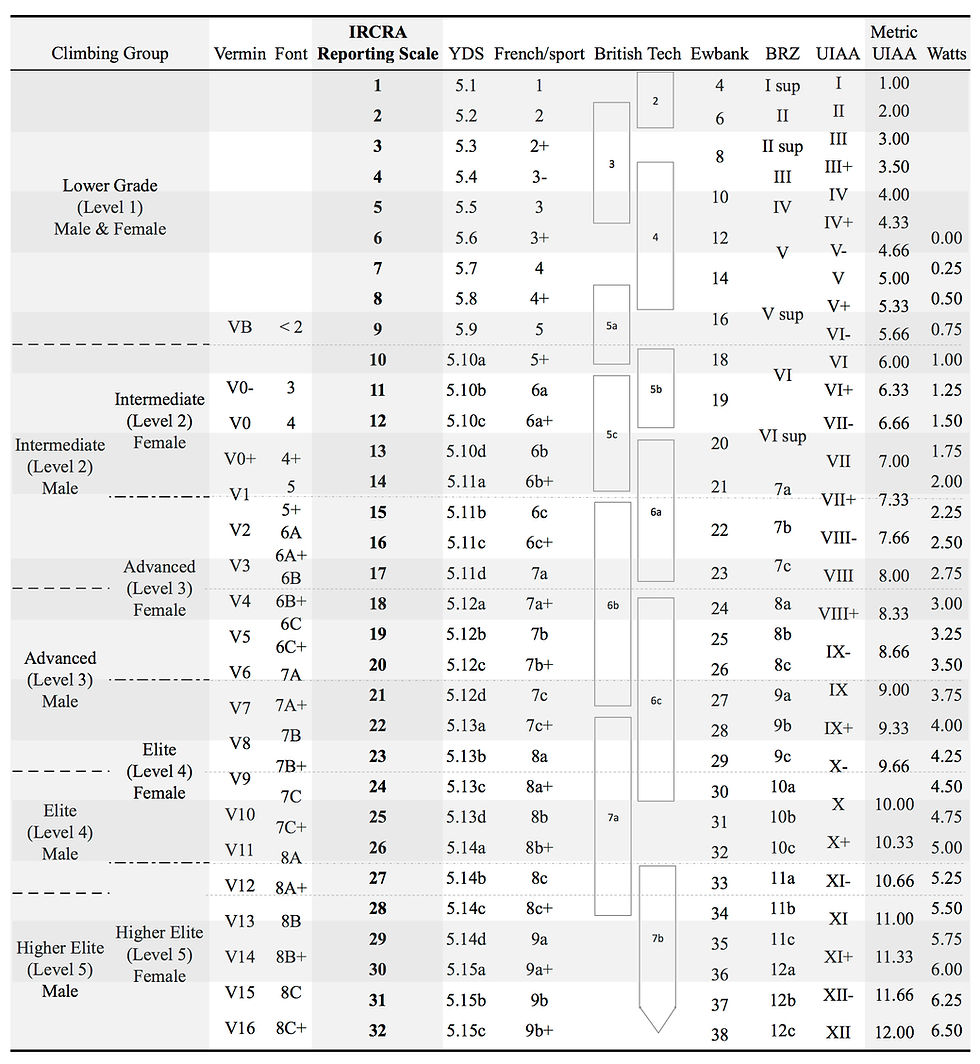Reporting Grades in Climbing Research
- Nick Draper and Dave Giles
- Sep 12, 2016
- 2 min read
The research base for rock climbing has expanded substantially in the past three decades as worldwide interest in the sport has grown. An important trigger for the increasing research attention has been the transition of the sport to a competitive as well as recreational activity and this has been heightened with the inclusion of sport climbing in the Tokyo 2020 Olympic schedule.
The International Rock Climbing Research Association (IRCRA) was formed in 2011 to bring together climbers, coaches and researchers to share knowledge and promote collaboration. In 2016 IRCRA published a position statement which was developed during and after the 2nd IRCRA Congress which was held in Pontresina, in September 2014. The aim of the position statement was to bring greater uniformity to the descriptive and statistical methods used in reporting rock climbing research findings.
Until recently there had been a wide variation in the information provided by researchers regarding the climbers’ characteristics and also in the approaches employed to convert from climbing grading scales to a numeric scale suitable for statistical analysis. The IRCRA position statement provided details for recommended standards of reporting to be used for reporting climber characteristics. In addition, the position statement provided a universal scale (the IRCRA scale) for the conversion of local/national climbing grades to a uniform/standardised number system for statistical analysis.

As a minimum, researchers should report answers to the following questions about the following characteristics of the climbers in a study to improve comparability between studies:
Climbers’ self-identity in the sport – how they see themselves in-terms of predominant discipline (i.e. boulderer, sport climber, etc.)?
Disciplines (i.e. bouldering, sport, traditional etc.) the climbers take part in (percentage of time devoted to each) in the past 3 and 12 months (include data for both time periods)?
Percentage of time spent climbing indoors or outdoors in the past 3 months and over the past 12 months?
Mean time (days per week and hours per session) spent climbing/training in a typical week in past 3 months and in the past 12 months?
Time in the sport – the number of years/months experience?
Are they involved in competition climbing, along with the disciplines and levels (i.e. bouldering, local versus national competitions)?
Additionally researchers might report the climbers’ preference for style of ascent, (i.e. onsight, redpoint, top-rope) and for terrain (vertical, overhanging, slab climbing, varied).
The full paper may be found here.
Reference as:
Draper, N., Giles, D., Schöffl, V., Fuss, F., Watts, P., Wolf, P., Baláš, J., España Romero, V., Gonzalez, G., Fryer, S., Fanchini, M., Vigouroux, L., Seifert, L., Donath, L., Spoerri, M., Bonetti, K., Phillips, K., Stöcker, U., Bourassa-Moreau, F., Garrido, I., Drum, S., Beekmeyer, S., Ziltener, J., Taylor, N., Beeretz, I., Mally, F., Amca, A., Linhat, C. & Abreu, E. (2016). Comparative grading scales, statistical analyses, climber descriptors and ability grouping: International Rock Climbing Research Association Position Statement. Sports Technology. [doi: 10.1080/19346182.2015.1107081]
Recent Posts
See AllDear IRCRA members, Faced with the COVID-19 pandemic, the global situation has made the coming months very uncertain. The virus is...








